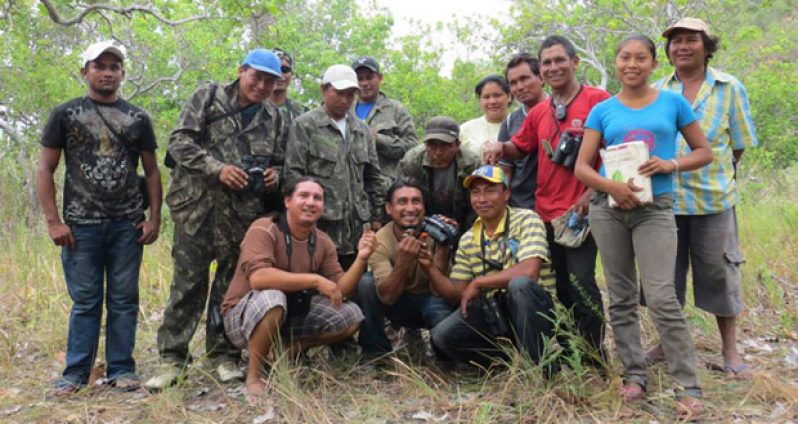– Smithsonian scientists use novel genetic approaches to help bring an iconic bird back from the brink of extinction.
Text and photos: Smithsonian’s Institute for Biodiversity Genomics

In Venezuela, the red siskin (Sporagra cucullata) is known as el Cardenalito—or “little cardinal”—a tribute to its vibrant colors. This charismatic bird is part of the country’s national identity: It is the official bird of Lara state, the subject of well-known folk songs, and its image appears on the highest denomination currency, the hundred bolívar fuerte note. It is also one of the most endangered birds in the world.
The red siskins’ distinctive red-and-black plumage made it desirable. The feathers and even whole birds adorned elaborate women’s hats and other clothing items in the early 1900s, and it has been a popular caged bird in many countries. Great numbers were captured for the pet trade, and even now trapping continues illegally. But the main reason for its disastrous decline was the popular early 20th-century quest to produce a red canary, causing the red siskin to be trapped almost to extinction to meet the demand of aviculturists who were hybridizing it with domestic canaries.
The red siskin once graced the skies in large flocks across northern Venezuela into Colombia and the island of Trinidad. Now the bird has disappeared in many of these places, and the few isolated groups in Venezuela may number only several hundred individuals. In recent decades, sightings in the wild have been increasingly scarce. That is, until a Smithsonian/University of Kansas expedition traveled to the Rupununi savannas of southern Guyana in 2000 and discovered a previously undocumented population.
That expedition was co-led by Michael Braun, a research scientist in the Department of Vertebrate Zoology at the National Museum of Natural History, and Mark Robbins, collections manager for ornithology at University of Kansas, who first spotted the rare birds. “It was like seeing a ghost,” says Braun. “Ornithologists had pretty much given up on this bird in the wild, outside of a small, local population in far western Venezuela near the border with Colombia.”

Robbins, recollecting the moment of discovery in Guyana said, “Quite unexpectedly, I heard siskins calling as they flew overhead and out of sight. A few minutes later I found the birds, including a male, sitting in the top of trees. When I realized what they were, I thought I must be dreaming.”
Even in their excitement, the researchers realized how extremely valuable these birds would be on the international black market for the pet trade, so they kept the information about their find a close secret while they sought official protection for the red siskin in Guyana. After it was added to the country’s endangered species list and legal protections against trafficking were in place, the scientists were able to publish their findings—without specific location information—to announce the discovery of Guyana’s population of red siskins to the ornithological community.
This important discovery attracted the interest of conservationists in Venezuela, who contacted Braun about protecting this bird. And from this, the Red Siskin Initiative was born.
The Red Siskin Initiative
Saving the red siskin has become a passion for Braun. He came to the Smithsonian 27 years ago to start a molecular genetics laboratory for the Institution, but also because he has always been interested in the biodiversity of the tropics. For his entire career, he has been involved with museum collecting and biodiversity documentation. Now, in addition to his work in genetics, he spearheads the Red Siskin Initiative, a multifaceted conservation effort to bring the bird back from the brink of extinction.
The Red Siskin Initiative is an international partnership of public and private institutions that aims to protect the population in Guyana and restore sustainable populations in Venezuela through reintroduction. The Smithsonian’s participation is significant, hosting the project coordinator position and drawing on expertise from Smithsonian scientists at the National Zoo, Conservation Biology Institute, Migratory Bird Center, Tropical Research Institute and National Museum of Natural History.
Project coordinator Brian Coyle explains: “It’s such a comprehensive effort—it includes habitat protection, captive breeding, sustainable agroforestry, education and community involvement, plus a cutting-edge genomics aspect that’s really exciting. It can serve as a model project for modern conservation.”
Guided by Genomics
In many ways, genomics will guide conservation efforts. Because extensive breeding efforts with other species like canaries have created numerous hybrid birds, it is important to be able to identify birds that look like red siskins, but have mixed ancestry, and exclude them from captive breeding programs for reintroduction. Critically small populations are also prone to inbreeding, with the associated health concerns. Genetic methods can gauge relatedness among potential mates to prevent inbreeding and insure success of breeding efforts.
The first step is to assemble a whole genome for the red siskin. By combining short-read and long-read DNA sequence data, a novel hybrid-assembly approach developed by scientists at the University of Maryland, they expect to produce one of the highest quality genome assemblies of any bird.
Armed with the red siskin’s whole genome, plus low-coverage shotgun sequencing of nine other wild individuals from Venezuela and Guyana, researchers can develop molecular tools to identify hybrid birds, prevent inbreeding, find markers for genetic disorders or disease, and understand the genetic differences between the two populations. The latter has become immediately relevant; preliminary data indicates that the two populations are genetically diverged to an extent that they will probably need to be managed as separate populations, and not bred together, in order to maintain evolutionary distinctness of each population.
The project is also working with Jesus Maldonado at the Smithsonian’s Conservation Biology Institute to extract DNA from museum specimens collected in the 19th and early 20th centuries across Venezuela and the Caribbean. These samples are critically important to understanding past genetic diversity and population structuring that will help inform future conservation management.
Jesus Maldonada says, “Our group at SCBI has played a big role in the development of ‘ancient DNA’ technologies to extract, capture and sequence DNA from old museum specimens. DNA from these ancient specimens gives us a more complete picture of how the red siskin has changed genetically over space and time.”
Protection in Guyana
Guyana’s red siskins are found in a remote area of about 70 by 100 miles. Since there seem to have been no known threats to this population prior to its discovery in 2000, monitoring and protection may be sufficient to sustain this population without additional external breeding efforts. However, habitat protection remains a priority, especially with the recent introduction of industrial mechanized agriculture to the area and the increasing frequency of fires in the savanna.
The main partner in Guyana is the South Rupununi Conservation Society. Many of the founding members of SRCS were guides and assistants to the Smithsonian expedition that discovered the red siskin population in 2000. “We have raised awareness of the bird in local communities, stopped its capture by local caged-bird traders, and guided many visiting birdwatchers to their first sightings of this exceedingly rare bird,” says Chung Liu of the SRCS. “Our experiences have been invaluable in understanding the feeding habits and behavioral patterns of this minute and rare bird.”
Researchers from the Smithsonian, SRCS and collaborating organizations have been conducting field studies to define the population size, density and distribution. SRCS has been collecting blood samples so that the Smithsonian can assess genetic diversity and viability, and they are also banding birds for future studies.
Recently, the project has been collaborating with the Environmental Protection Agency–Guyana and Bird Life International to develop strategies for red siskin habitat protection that include establishing an Important Biodiversity Area.
In Guyana, efforts are focused on nurturing a culture of community pride and support for protection of the red siskin through training in conservation research and administration for volunteers from communities in the Rupununi region, promoting sustainable economic opportunities like eco-tourism and shade coffee, and developing a variety of environmental education programs for Amerindian schools and villages.
A Teachable Moment
The red siskin is a high profile, charismatic, endangered species, and saving it will generate knowledge and awareness that can be translated to other threatened species.
“It’s a teachable moment,” says Braun. “This bird is endangered because too many of them were harvested without regard to what the natural population could sustain. And that lesson then translates to many, many other aspects of how humans use and interact with their environment, such as overfishing, clear-cutting of forests and overdependence on fossil fuels.”
“We hope to have success at reintroducing the red siskin and recovering it to the point where it doesn’t need intensive management,” continues Braun. “It can be an example of wise use of the environment so that people understand that we need to pay attention to all aspects of how we’re using the environment in order to sustain the biodiversity and ecosystem services that we take for granted.”




.png)









